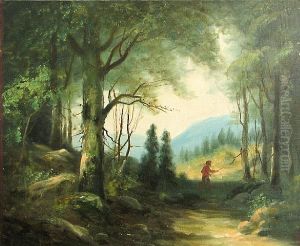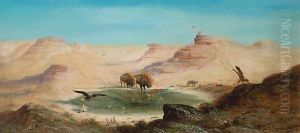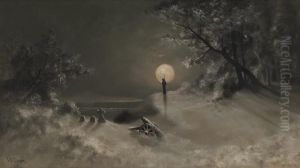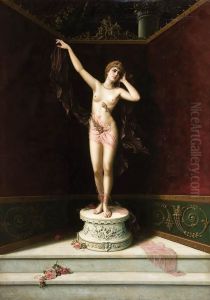Adm Cooper Paintings
Astley David Middleton Cooper, known as A.D.M. Cooper, was an American painter born on December 23, 1856, in St. Louis, Missouri. Cooper's works primarily focused on the American West, including scenes of Native Americans, landscapes, and portraits, as well as classical and allegorical subjects. He was also known for his somewhat bohemian lifestyle and colorful personality, which often overshadowed his contributions to art during his lifetime.
Cooper's journey into the world of art began after he moved to California in the late 1870s, where he was initially engaged in various jobs before deciding to pursue a career in painting. He traveled to Paris to study, which was a common path for American artists seeking formal training during that period. In Paris, Cooper immersed himself in the academic style of painting, honing his skills in the depiction of the human figure and classical composition. Upon returning to the United States, he settled in San Jose, California, which remained his base for the rest of his life.
Throughout his career, Cooper became well-known for his large canvases celebrating the Old West. His paintings often depicted dramatic scenes of Native American life, capturing moments of conflict, ceremony, and daily life with a romanticized flair that appealed to the sensibilities of his contemporary audience. In addition to his Western scenes, Cooper also painted portraits of prominent citizens and was a favored artist among the elite of California. His skills as a portraitist were highly regarded, and he received numerous commissions that contributed to his financial success.
Cooper's work was not limited to the genres for which he is best known. He also ventured into allegorical and historical paintings, including a series of works that depicted important moments in California's history. These pieces were ambitious in scale and scope, reflecting his aspirations to contribute to the cultural legacy of his adopted state.
Despite his success, Cooper's lifestyle and eccentricities often garnered as much attention as his artwork. He was known for his flamboyant personality and was a prominent figure in the social and artistic circles of California. Stories of his unconventional behavior, including paying debts with paintings and hosting lavish parties, have become part of the lore surrounding the artist.
A.D.M. Cooper passed away on June 3, 1924, in Santa Clara, California. Today, his works are considered important for their contribution to the visual culture of the American West. They are held in various public and private collections, serving as a testament to the enduring appeal of the themes and subjects he depicted. Cooper's legacy is also tied to his role in the development of the art scene in California, where he was a pivotal figure in the state's emerging artistic community in the late 19th and early 20th centuries.



